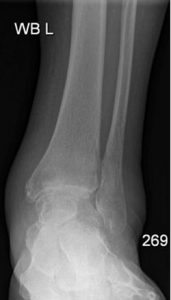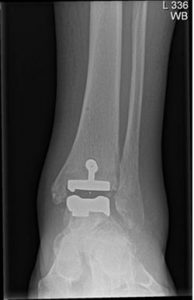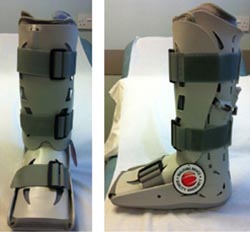 What will the surgery involve?
What will the surgery involve?
i. Anaesthetic – usually a general anaesthetic is required; as well as this, local anaesthetic will usually be placed around the nerves that provide the sensation to your ankle and foot (popliteal nerve block). This will mean that the foot/ ankle is likely to be numb when you wake after the surgery- this usually lasts between 12 and 24 hours. You will have a chance to discuss your anaesthetic with the anaesthetist before the operation.
ii. Incisions – a longitudinal incision is made along the front of the ankle.
iii. The surgery – The edges of the bone on both sides of the joint are removed and replaced with specially designed metal to resurface these bones, these are coated with material that allows the bone to stick to them, no cement is required. When these metal coverings have been put in place (obtaining the correct alignment, angulation and rotation can be complicated) a specially designed polyethylene insert is placed between the metal surfaces.
iv. Stitches – Dissolvable sutures will usually be used to close the skin.
v. Dressings – Special dressings will be placed on the ankle and a plaster back slab will be applied, this should all be left in place until you are reviewed in the clinic at two weeks following the operation. The dressing and plaster will then be removed and a new light dressing applied over the wound and the plaster exchanged for a walking boot.
The plaster should be kept dry, applying a waterproof cover when showering is useful, the most commonly used can be found at www.limboproducts.co.uk
 What happens after the surgery?
What happens after the surgery?
i. Going home – This will usually be the morning following surgery, depending on your progress on crutches and home situation.
ii. Pain relief – The local anaesthetic applied around the knee should provide pain relief and is likely to make the foot and lower leg numb for about 24 hours. You will also be supplied with pain relieving tablets by the hospital (usually co-codamol and tramadol) these should be taken regularly initially. You can gradually reduce these as your pain allows (tramadol is the stronger pain killer).
You will find it more comfortable to keep your foot elevated, if possible above the level of your heart, as much as you can for the first two weeks after surgery. This will help reduce the swelling and therefore also help wound healing.
iii. Walking – The amount of weight you will be able to apply through the foot/ ankle is as follows:
Weeks 0-2 No weight in a back slab plaster
Weeks 2-6 The plaster will be changed for a walking boot at your out patient appointment. You will be able to gradually increase the amount of weight you place through the foot and ankle during this period. You will usually be able to start walking without the boot at about 6 weeks
iv. Driving – If you the surgery is on your left ankle and you have an automatic car you may be able to drive after the outpatient appointment at two weeks after surgery, but you should check with your insurance company first.
If the surgery is on your right ankle you will not be able to drive until you can walk without crutches confidently. At this point you should check that you can place your foot on the pedal with sufficient force to do an emergency stop without pain, this should be tried in a stationary car. When you are able to do this you should then contact your insurance company to ensure that they will provide cover for you.
 v. Follow up – You will be reviewed in the outpatient clinic at:
v. Follow up – You will be reviewed in the outpatient clinic at:
2 weeks after surgery when the plaster ’back slab’ will be removed and wound will be checked. A pneumatic walking boot will then be applied.
6 weeks after surgery when an X Ray will be obtained, if this is satisfactory you will be able to start walking without the boot.
3 months after surgery and further follow up will then depend on your progress, but you will be kept under at least yearly review for the first five years.
vi. Return to work – Approximately:
Office job – 4 weeks
Mobile job requiring driving – 8 weeks
Manual labour – 12 weeks
What are the risks of the operation?
There are a small number of risks of surgery including infection, nerve damage, blood clots, ongoing pain and the need for further surgery (please see General Risks of Foot and Ankle Surgery for further information)
